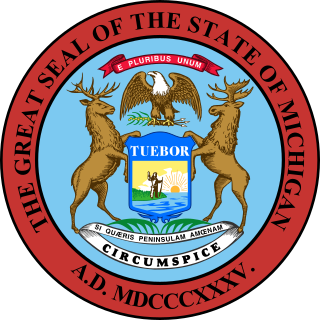Related Research Articles
Administrative law is a division of law governing the activities of executive branch agencies of government. Administrative law includes executive branch rule making, adjudication, and the enforcement of laws. Administrative law is considered a branch of public law.
The following outline is provided as an overview of and introduction to law:
Regulation is the management of complex systems according to a set of rules and trends. In systems theory, these types of rules exist in various fields of biology and society, but the term has slightly different meanings according to context. For example:
Case law, also used interchangeably with common law, is a law that is based on precedents, that is the judicial decisions from previous cases, rather than law based on constitutions, statutes, or regulations. Case law uses the detailed facts of a legal case that have been resolved by courts or similar tribunals. These past decisions are called "case law", or precedent. Stare decisis—a Latin phrase meaning "let the decision stand"—is the principle by which judges are bound to such past decisions, drawing on established judicial authority to formulate their positions.

A decree is a legal proclamation, usually issued by a head of state, judge, royal figure, or other relevant authorities, according to certain procedures. These procedures are usually defined by the constitution, Legislative laws, or customary laws of a government.

A government agency or state agency, sometimes an appointed commission, is a permanent or semi-permanent organization in the machinery of government (bureaucracy) that is responsible for the oversight and administration of specific functions, such as an administration. There is a notable variety of agency types. Although usage differs, a government agency is normally distinct both from a department or ministry, and other types of public body established by government. The functions of an agency are normally executive in character since different types of organizations are most often constituted in an advisory role — this distinction is often blurred in practice however, it is not allowed.
In administrative law, rulemaking is the process that executive and independent agencies use to create, or promulgate, regulations. In general, legislatures first set broad policy mandates by passing statutes, then agencies create more detailed regulations through rulemaking.
United States Federal Administrative Law encompasses statutes, rules, judicial precedents, and executive orders, that together form administrative laws that define the extent of powers and responsibilities held by administrative agencies of the United States government, including executive departments and independent agencies. Because Congress, the president, and the federal courts have limited resources to address all issues, specialized powers are often delegated to a board, commission, office, or other agency. These administrative agencies oversee and monitor activities in complex areas, such as commercial aviation, medical device manufacturing, and securities markets.

The law of California consists of several levels, including constitutional, statutory, and regulatory law, as well as case law. The California Codes form the general statutory law, and most state agency regulations are available in the California Code of Regulations.
The law of Florida consists of several levels, including constitutional, statutory, and regulatory law, as well as case law and local law. The Florida Statutes form the general statutory law of Florida.
Regulatory science is the scientific and technical foundations upon which regulations are based in various industries – particularly those involving health or safety. Regulatory bodies employing such principles in the United States include, for example, the FDA for food and medical products, the EPA for the environment, and the OSHA for work safety.

The Administrative Procedure Act (APA), Pub. L. 79–404, 60 Stat. 237, enacted June 11, 1946, is the United States federal statute that governs the way in which administrative agencies of the federal government of the United States may propose and establish regulations, and it grants U.S. federal courts oversight over all agency actions. According to Hickman & Pierce, it is one of the most important pieces of United States administrative law, and serves as a sort of "constitution" for U.S. administrative law.

Administrative law in Mongolia is the body of law that governs the activities of administrative agencies of the Mongolian government. These activities include rulemaking, adjudication, or the enforcement of a specific regulatory agenda.
The law of Virginia consists of several levels of legal rules, including constitutional, statutory, regulatory, case law, and local laws. The Code of Virginia contains the codified legislation that define the general statutory laws for the Commonwealth.
The law of Texas is derived from the Constitution of Texas and consists of several levels, including constitutional, statutory, regulatory law, as well as case law and local laws and regulations.

The law of Michigan consists of several levels, including constitutional, statutory, regulatory and case law. The Michigan Compiled Laws form the general statutory law.
The law of New Jersey consists of several levels, including constitutional, statutory, regulatory, case law, and local law.
The law of Massachusetts consists of several levels, including constitutional, statutory, regulatory, case law, and local ordinances. The General Laws of Massachusetts form the general statutory law.
The law of Washington consists of several levels, including constitutional, statutory, regulatory and case law, as well as local ordinances. The Revised Code of Washington forms the general statutory law.
Primary legislation and secondary legislation are two forms of law, created respectively by the legislative and executive branches of governments in representative democracies. Primary legislation generally consists of statutes, also known as 'acts', that set out broad principles and rules, but may delegate specific authority to an executive branch to make more specific laws under the aegis of the principal act. The executive branch can then issue secondary legislation, creating legally enforceable regulations and the procedures for implementing them.
References
- ↑ John F. Duffy, "Administrative Common Law in Judicial Review", Texas Law Review 77, no. 1 (1998–1999): 113–214
- ↑ A. I. Ogus, "Regulatory Law: Some Lessons from the Past", Legal Studies 12, no. 1 (March 1992): 1–19